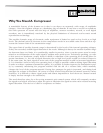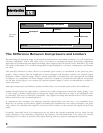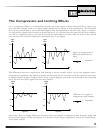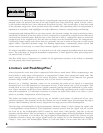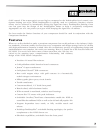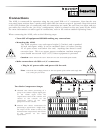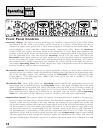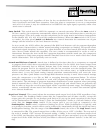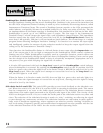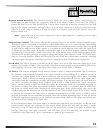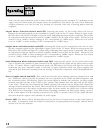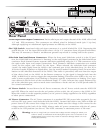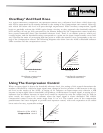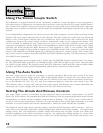
increase in output level, regardless of how far the set threshold level is exceeded. This occurs in
both OverEasy® and hard knee operation. Note that when a compressor is set to a compression
ratio of 10:1 or more, it may be considered to be LIMITING the input signal, especially when a fast
attack time is selected.
Auto Switch: This switch sets the 162SL for automatic or manual operation. When the Auto switch is
IN (A
UTO
mode), the compressor automatically adjusts its attack rate and release time to suit the pro-
gram envelope. (This A
UTO
mode sets the compressor for the same attack and release characteristics
as dbx Models 160, 161, 162, 163 and 164 compressor/limiters.) When the Auto switch is OUT (
MAN
-
UAL
mode), the front panel Attack and Release rate controls determine the maximum rate of gain
change and the behavior of the level detector circuitry.
In A
UTO
mode, the 162SL utilizes the patented dbx RMS level detector with its program-dependent
attack/release characteristics to obtain natural-sounding compression or limiting. For special effects
and certain signal situations, however, it is often desirable to set fixed attack and release character-
istics. M
ANUAL
mode affords this capability. The A
UTO
mode is recommended for vocals as well as
instruments. Because the A
UTO
mode has a program dependent variable attack rate, the compressor
may compress or limit some program material smoother than in the
MANUAL
mode which has a fixed
attack characteristic. This is especially true on vocals.
Attack and Release Controls: Attack time is defined as the time taken for a compressor to respond
to program levels which have exceeded the threshold point. For the 162SL, this control ranges from
400dB/mS (extremely fast) to 1dB/mS. Release time is the amount of time a compressor takes to
return the program level to its original level, after the last excursion over the threshold point. The
162SL’s release times range from 4000dB/second (very fast release time), to 10dB/second (slow
release time). A very fast attack setting (control maximum counterclockwise) will cause the com-
pressor to act like a peak limiter even though RMS detection circuitry is used. Slower attack settings
cause the compressor to act like an RMS or averaging detecting compressor/limiter. To achieve
inaudible compression, it is advisable to work with program dependent attack and release times
(Auto mode). The advantage of program dependent compression is most apparent when processing
musical material that is varied. For compression, longer attack and release times are generally the
best in order to keep the overall output signal within a specified dynamic range. For limiting appli-
cations, considerably shorter attack and release times are necessary to control fast transient signals
or to increase headroom.
Stop Level Control: This control adjusts the maximum peak output level of the 162SL regardless of any
other control. The PeakStop limiter comes after the compression and all other circuitry, except the
output gain; this provides for an absolute peak limit to be put on the peak excursions at the output
via the Instantaneous Transient Clamp™. Since the PeakStopPlus
®
limiter is a fail-safe limiter it must
come after the Output Gain control. If the output gain is set too high as compared to the
PeakStopPlus
®
Level control, continuous limiting can occur. While PeakStopPlus is typically used
as a protective function, creative effects can be achieved by intentionally driving the signal into heavy
PeakStopPlus limiting. Like the range of the Threshold control, the scale of the Stop Level control
is measured in dBu. The control ranges from +4dBu, all the way to “OFF” (+24dBu). The top end of
the scale is marked “OFF” because its internal setting, +24dBu, is the actual maximum output level
of the 162SL, and therefore signal passing through the unit will pass untouched, up to the maximum
output level of the 162SL. Because of this, the limiter is effectively rendered “inactive” in the OFF set-
ting.
11



